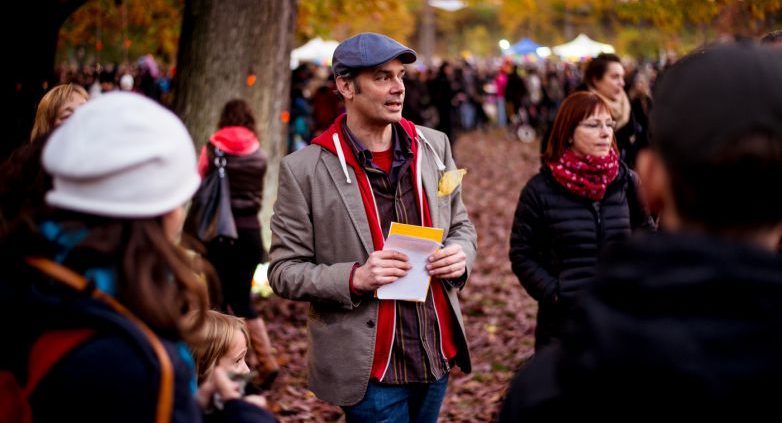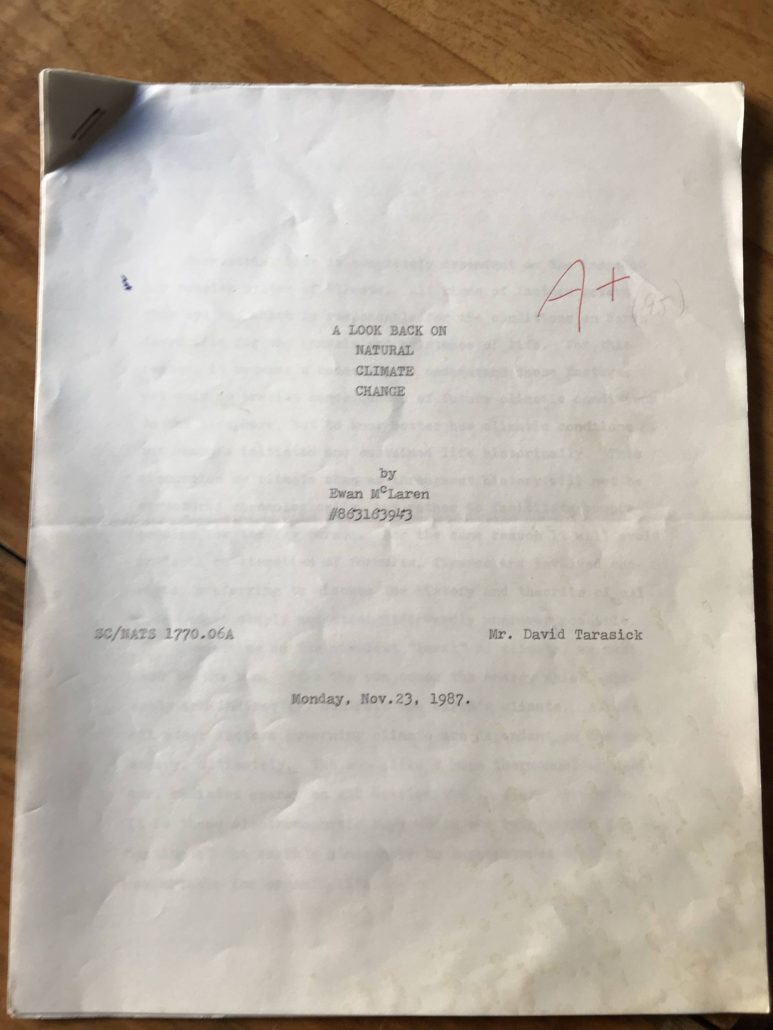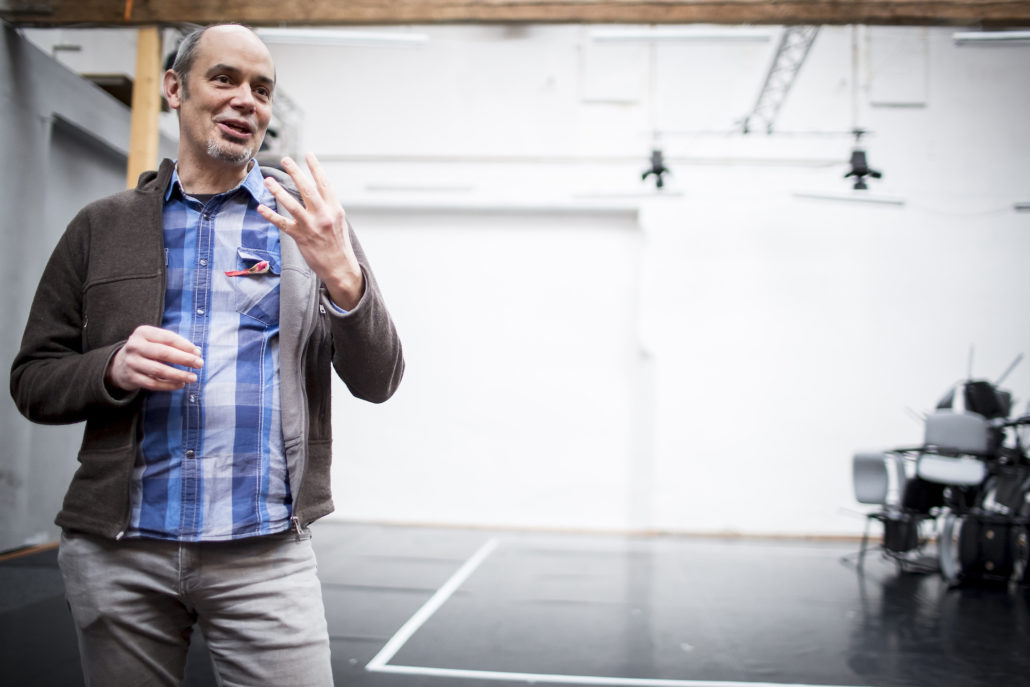Ewan McLaren’s Energy Pathways

Photograph: archive of the Alfred ve dvoře theater
The seventh edition of Bazaar Festival took place in Prague from 27th to 30th August 2021. Its theme this year, We the Landscape, marked a definitive shift towards environmental issues. Martin Macháček spoke to its dramaturg and “spiritual father” Ewan McLaren about the landscape of the festival today.
I consider Bazaar a politically defined festival since its beginnings. What made you as its dramaturge switch the focus from socially oriented topics, human rights atop them, to the so-called anthropocene? Do you reckon climate as a political matter?
It’s true that from the start seven years ago, Bazaar Festival was mostly for (Central and East European) dance and theatre artists dealing with questions of identity. Things have shifted naturally to a wider focus and now it’s a festival of independent innovating dance and theatre creators reacting to the political and social situations in their cities and countries. I was lucky to get the funding for lots of travel in 2019 before COVID struck, and what I noticed was that many artists in Slovenia, Poland, Ukraine, Hungary and others were dealing with environmental questions in their work. This tied in with my own past with the Energy Pathways site specific performance project on oil, coal, uranium and water history (Cesty energie, 2009-2015) with Miroslav Bambušek. Plus, we have been having lots of discussions with Bazaar team members Lucia and Bara about working with communities outside the „city culture bubble“ in future and greening the festival, many things pointed us towards this new direction. In any case, in order to deal with environmental questions seriously, we find they are becoming questions of identity – hence the We the Landscape theme – and the urgency of the situation means this is a political and social theme.
From another perspective, there was a dance creator from Poland we have followed for a time – Agata Siniarska, and her past works were very much about identity. Such as Mothers of Steel which she created, with our support, with Romanian dance creator Mădălina Dan. But in 2019 Poland’s Nowy Teatr invited us to see shiny new Polish works of theatre and dance – and there she was! With top Polish dance personalities on an island in paradise but with a jarring, haunting lighting design, presenting the first work of her trilogy on our relationship to the natural world! The movement from personal identity to our environmental identity seems to be happening in more places at once. From this impulse the dramaturgical focus springs this year on dance and the environment – following Agata’s YOU ARE SAFE we also bring Czech POCKETART’s Treatment of Remembering and works from Bratislava (Jana Tereková’s work FETTERED TO THE MOMENT) and Budapest. Hungary’s Zsuzsa Rozsavolgyi is a phenomenal dance creator who has moved between larger choreographic creations on the natural world and questions of identity since 2014 – Bazaar audiences will remember her provocative performance “1.7” about women being expected to have more and more children in 2018 – and now she is back with a “lecture dance” on the differences between human and animal anatomy called Anthropodeny – is that about identity or the environment? Both!
We tried to find out what to do with a unique, six-hour-long, award-winning Slovenian performance Together by Leja Jurišić a Marek Mandič that we were not able to put on stage last year due to covid restrictions. Their theme is not the natural world. But then we realized that these consummate artists – one of them a daring dancer and performance artist, the other a starring drama actor of the Slovenian National Theatre with a rare knack for performing with his whole body – do an outdoor version of this ever-changing performance about how to live, work and love Together – and we said: We have to bring it to our audiences at last! It will take place in the amazing garden of Studio ALTA – and if it is not performance about the environment, at least it will be environmental performance!

The Amazon Basin, Australia, California, Siberia, recently Greece, or Turkey – they all were or have been on fire. Canada was also hit hard by the heatwave. Is this a personal topic for you?
Very personal, as I was born in Canada, namely Calgary in Alberta, the capital of oil.
Even though I studied theatre and acting at the university in Toronto, they forced me to take one course of natural science. It was 1987 and I found myself in a lecture hall full of rough scientists and experts on climate. They spoke about models which were able to predict the results of greenhouse effect such as abrupt weather changes or glacier melting and compare them to the natural thaws in the past. They explained how polar glacier melting would change the salinity of oceans enough to slow down important sea currents (e. g. the Gulf Stream) whose job is to warm Europe. People will get confused because some parts of the world would face a temperature drop, and they would think: “What (global) warming and drought? It’s cold and plenty of floods.” Those people forced us to imagine the future, i. e. what happens if humankind does not realize the risks in time and does not restrict the use of fossil fuels. I was an actor-to-be and as such, I had no idea what to do about things. No one had a clue that Communism in Europe would fall apart before long, that the market would open, and China would grow economically and industrially… After almost 40 years, Canada faced an extreme heatwave this year (imagine 49 degrees Celsius!!!). Also, the forest fires came earlier than usual, and persevere. Europe had to adapt to torrential rain and extreme floods. The first reports suggest that the Gulf Stream is collapsing… And those are just some of the paradoxes of environmental science. I realized that there are middle-European artists who are trying to understand such paradoxes and describe them to the audience via examples from their surroundings. They are examining open pit brown coal mining in Germany, Czech Republic, and Poland; the state of water and forests; our dependence on oil; the loss of biodiversity; the necessary distance from human behaviour only geological time can provide. All this is part of an important cultural shift. It is worth inviting such artists to meet Czech audience. And not only them – this year we have also invited leading Central European scientists to join us!
The recent report by Intergovernmental Panel for Climate Change (IPCC) is clear: global warming has been caused by men. Yet, many people fly to perform at international festivals. How about that? Where do you see the future of internationalized festivals that are of such importance to dance, performance, and theatre?
I think we already made a reasonable choice when we created this festival: instead of focussing on being international in the sense of overseas connections and intercontinental ones, we said: Let’s focus on the fascinating and half-forgotten cultural pathways of Central and Eastern Europe, on occasion stretching further to the Middle East. In past editions we did fly artists here even from closer countries but we have been changing our approach in line with our convictions and our festival themes. For this year’s We the Landscape edition, to the best of my knowledge everybody is coming by train, with the one exception of the Russian ensemble AKHE who have to get here from St. Petersburg. For our festival it should be possible in future to keep flights at a minimum. Yet I think we will always have one artist or project that will fly here because it is our job to keep Czech audiences in touch with the world – and getting them to Prague by surface travel from Lebanon for example, or Russia is no easy project.
What is your idea of sustainable theatre?
That is another paradox – we all know it is more sustainable to focus on “local” works and artists, but if our job is also to put the periscope UP and show audiences what is around out there, farther away we have to be careful to pick and choose at least several important works and artists from further afield to “provoke” our audiences’ and artists’ imagination and expand their consciousness.
You can compare the situation here to that in Europe and/or the world. How do the theatres there reflect on sustainability, if so?
Many festivals are saying they will only accept artists flying if they live more than 700 Km away but are careful to make sure there are just still a few such projects coming in from farther away. Just as there is the Gulf Stream in the oceans moderating temperatures on the surface of the planet there is a life giving circulation of cultural ideas and approaches and we must prevent that from getting cut off completely.

To be a bit more optimistic: Saturday Bazaar provided a crucial contribution to local creative environment. Are you satisfied with its development? Did you expect it to grow like this?
We are always looking for ways to improve how the Saturday Bazaar part of our festival serves as a way to let artists take their works in development a step further with new impulses and inspirations from “confrontations” with curious audiences before their premieres, and also bring audiences to understand the artistic process of independent performing arts creation better. We struggle to keep the event intimate, but the demand in terms of the number of worthy artistic projects in development is higher than we can support. This year we feature six amazing projects, including two by Czech-based artists: Kateřina Szymanski and Alica Minar, plus works for Germany, Poland, Hungary, and Slovakia. Every year we make sure to present at least one of the now full-fledged, finished works the Saturday Bazaar helped develop last year. This year it is POCKetART’s Treatment of Remembering, in its outdoor version.
In what ways do you expect Bazaar to develop in the future?
The growth of Bazaar Festival audiences surprised me. After 2019 we started looking for theatres with bigger capacities to fulfil demand and bring up our ticket sales, but then the pandemic hit… This got us thinking about another kind of growth. How can Bazaar Festival be about innovating performing arts from our countries that are in dialogue with small towns and disadvantaged communities? We are only just exploring how this could transform the festival in the next three to five years.
We believe that economic changes are coming, because of climate change and resulting changes in the economy that will make life very hard for large groups of people. By then we need to know how to be not just in dialogue with these people but allow them to express themselves.
In the meantime we are exploring themes like the migration of labour, goods and birds in 2022. And for 2023 we are looking at Devětsil’s Bazaar moderního umění of 1923 as inspiration for a Bazaar živého umění. Examining how dance and performance work as visual art and in gallery spaces, and vice versa.
Interviewer: Martin Macháček
Translation into English: Markéta Polochová
This interview was originally published online in Taneční zóna magazine.


